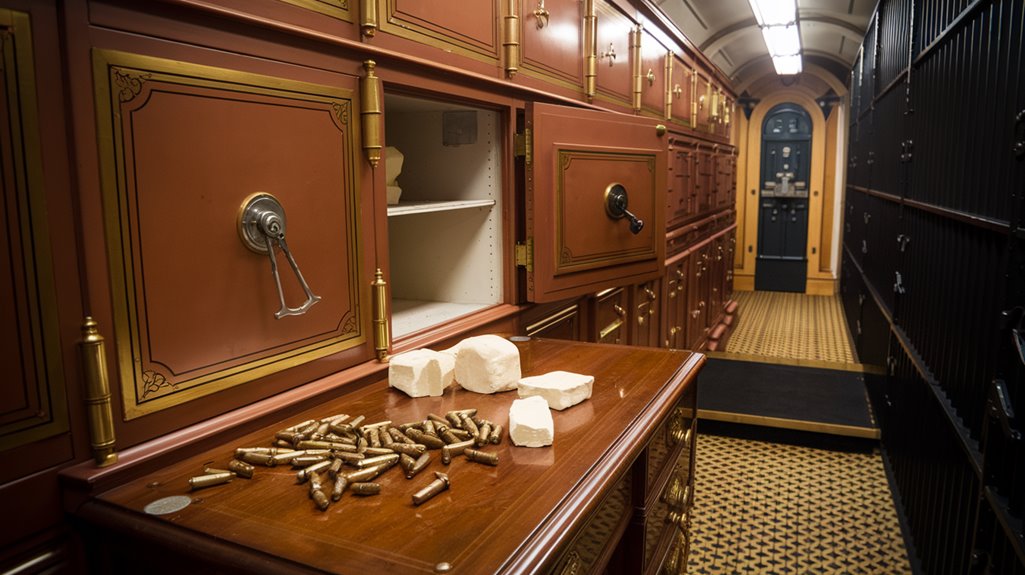The Great Gold Robbery of 1855: The Daring London-Paris Heist
You've probably heard of daring train robberies from the American Wild West, but Britain's Great Gold Robbery of 1855 puts them all to shame. When £12,000 in gold vanished during a routine London-to-Paris transport, it wasn't just the size of the heist that made history – it was the brilliant deception behind it. The masterminds didn't use guns or violence; they employed something far more powerful: inside knowledge and patient planning that would expose Victorian railway security for what it truly was.
Setting the Stage: Britain, Gold, and the Crimean War

While Britain had established its gold reserves in 1816, the 1850s brought unprecedented challenges to the nation's monetary system.
You'd find the Bank of England struggling to maintain stability as the Crimean War drained its resources, even as new gold discoveries in Australia and the United States flooded the market.
Despite the surge in global gold production, Britain's economic pressures intensified.
The Bank's gold stock had actually decreased by £10 million between 1852 and 1857, while massive gold exports to France and other European countries reached staggering levels.
The war's demands created a perfect storm: while gold coin circulation within the UK had increased to over £50 million, the country's need to finance its military efforts in Crimea constantly threatened to deplete these reserves.
The Bank of England, which had been holding gold since 1694, found itself in an increasingly precarious position during this turbulent period, making it vulnerable to schemes like the 200 pounds of gold that would soon be stolen in the infamous railway heist.
The Masterminds Behind History's Most Calculated Train Theft
Behind Britain's most audacious gold heist stood four unlikely partners who transformed railway security vulnerabilities into a masterful criminal enterprise. At the helm was William Pierce, a former railway employee whose mastermind motivations stemmed from his gambling habits.
He partnered with Edward Agar, a skilled safe-cracker, while William Tester and James Burgess provided essential inside access to South Eastern Railway's operations. The crew successfully cracked two safes and stole €12,000 in gold.
The heist implications reached far beyond their initial success. Though they'd meticulously planned every detail – from taking wax impressions of safe keys to replacing gold with lead shot – their downfall came from unexpected betrayal. The railway company responded by developing special bullion vans to prevent future thefts.
When Agar was arrested for another crime, Pierce's disloyalty sparked a chain reaction. Fanny Kay, Agar's partner, ultimately exposed the scheme when left without financial support, leading to the arrest and conviction of all four men.
The Perfect Plan: Wax Impressions and Lead Shot Deception
Through meticulous planning and expert craftsmanship, the robbers engineered a deception that would fool even the most vigilant railway authorities.
You'd never guess their ingenious method: they took wax impressions of the safe keys and spent months perfecting duplicate copies until they worked flawlessly.
The real brilliance lay in their use of lead shot from Lambeth's Shot Tower.
You see, they'd calculated the exact weight needed to match the gold they'd steal. They'd transport this lead shot onto the train in courier bags, swap it with the gold during the journey, and carry off their precious cargo in carpet bags.
James Burgess and William Tester helped execute the plan from the inside as railway employees, giving the gang crucial access to secure areas.
To complete the illusion, they'd reseal the boxes using homemade dies that mimicked official seals, ensuring any damage was carefully concealed.
The theft went undetected until the shipment reached its destination in Paris, where officials finally discovered the substitution.
Pulling Off the Impossible: The London Bridge to Folkestone Operation
On May 15, 1855, the most audacious railway heist in British history unfolded as Edward Agar slipped into the guard's van of the South Eastern Railway train bound for Folkestone.
Train security was laughably weak – only one lock secured the safe containing precious gold bars destined for Paris. Using his expertly crafted replica keys, Agar executed his robbery tactics with surgical precision. He skillfully removed the rivets from the iron-banded boxes, pried open the lids with wedges, and swapped the gold bars with lead shot to maintain the boxes' weight. The stolen goods were valued at £12,000 in total. James Burgess, a senior guard, signaled the operation was clear by wiping his face with a handkerchief.
You wouldn't have noticed anything amiss as Agar meticulously restored the boxes, applying counterfeit wax seals he'd created.
At Dover, he and Pierce calmly collected their golden prize and caught the 2:00 am train back to London.
Scotland Yard's Hunt and Agar's Shocking Confession

While bullion merchants first noticed weight discrepancies in their French shipments, they couldn't pinpoint where the gold had vanished.
Clean Willy's murder by Barlow significantly complicated the investigation, eliminating a key police informant.
Scotland Yard dispatched Sergeants Smith and Thornton to France, where they discovered English-made lead shot, suggesting the theft occurred in the UK.
The breakthrough came unexpectedly when Edward Agar, imprisoned for an unrelated fraud, sought revenge against William Pierce for abandoning his ex-girlfriend and child.
After Pierce ignored Agar's plea for help, Fanny Kay approached Newgate Prison's governor with vital information.
In Newgate prison, Agar faced charges of forgery under various aliases including Archer and Adams.
Agar's confession revealed the entire plot, leading to the arrests of Pierce, Burgess, and Tester.
 lead shot replacements in the gold boxes led to mandatory weight verification at multiple checkpoints.
lead shot replacements in the gold boxes led to mandatory weight verification at multiple checkpoints.
The heist's aftermath revolutionized our understanding of criminal psychology and the importance of insider threats. Railways began thorough staff vetting processes and introduced regular security audits. The involvement of ex-railway employee Pierce demonstrated why screening personnel became crucial.
You can trace many modern security practices back to this watershed moment, from tamper-evident packaging to multi-layered verification systems.
Today, the case continues to influence security studies, reminding you that successful protection requires constant vigilance, sophisticated technology, and well-trained personnel.
It's a demonstration of how one audacious crime can reshape an entire industry's approach to security.










